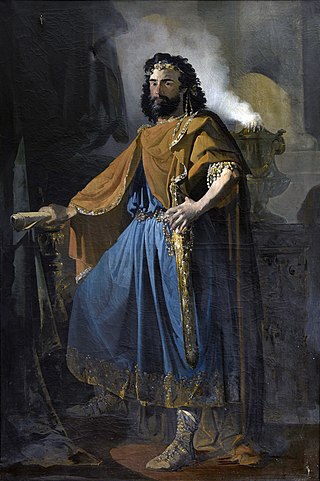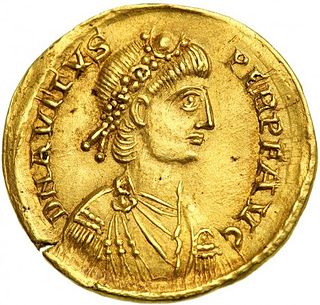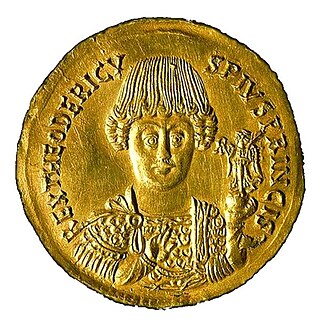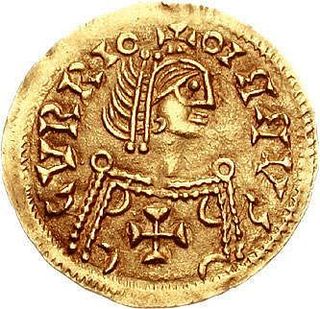
Alaric II was the King of the Visigoths from 484 until 507. He succeeded his father Euric as king of the Visigoths in Toulouse on 28 December 484; he was the great-grandson of the more famous Alaric I, who sacked Rome in 410. He established his capital at Aire-sur-l'Adour in Aquitaine. His dominions included not only the majority of Hispania but also Gallia Aquitania and the greater part of an as-yet undivided Gallia Narbonensis.
The 430s decade ran from January 1, 430, to December 31, 439.
The 450s decade ran from January 1, 450, to December 31, 459.

Year 451 (CDLI) was a common year starting on Monday of the Julian calendar. At the time, it was known as the Year of the Consulship of Marcianus and Adelfius. The denomination 451 for this year has been used since the early medieval period, when the Anno Domini calendar era became the prevalent method in Europe for naming years.

Year 458 (CDLVIII) was a common year starting on Wednesday of the Julian calendar. At the time, it was known as the Year of the Consulship of Maiorianus and Leo. The denomination 458 for this year has been used since the early medieval period, when the Anno Domini calendar era became the prevalent method in Europe for naming years.

Aetius was a Roman general and statesman of the closing period of the Western Roman Empire. He was a military commander and the most influential man in the Empire for two decades (433–454). He managed policy in regard to the attacks of barbarian federates settled throughout the West. Notably, he mustered a large Roman and allied (foederati) army in the Battle of the Catalaunian Plains, ending a devastating invasion of Gaul by Attila in 451, though the Hun and his subjugated allies still managed to invade Italy the following year, an incursion best remembered for the ruthless Sack of Aquileia and the intercession of Pope Leo I.

Euric, also known as Evaric, son of Theodoric I, ruled as king (rex) of the Visigoths, after murdering his brother, Theodoric II, from 466 until his death in 484. Sometimes he is called Euric II.

Eparchius Avitus was Roman emperor of the West from July 455 to October 456. He was a senator of Gallic extraction and a high-ranking officer both in the civil and military administration, as well as Bishop of Piacenza.

The Ostrogothic Kingdom, officially the Kingdom of Italy, existed under the control of the Germanic Ostrogoths in Italy and neighbouring areas from 493 to 553.
The Gothic Wars were a long series of conflicts between the Goths and the Roman Empire between the years 249 and 554. The main wars are detailed below.

The Visigothic Kingdom, Visigothic Spain or Kingdom of the Goths, was a kingdom that occupied what is now southwestern France and the Iberian Peninsula from the 5th to the 8th centuries. One of the Germanic successor states to the Western Roman Empire, it was originally created by the settlement of the Visigoths under King Wallia in the province of Gallia Aquitania in southwest Gaul by the Roman government and then extended by conquest over all of Hispania. The Kingdom maintained independence from the Eastern Roman or Byzantine Empire, whose attempts to re-establish Roman authority in Hispania were only partially successful and short-lived.

Theodoric I was the King of the Visigoths from 418 to 451. Theodoric is famous for his part in stopping Attila at the Battle of the Catalaunian Plains in 451, where he was killed.
The Battle of Arelate was fought in 458 near Arelate (Arles) between Western Roman Emperor Majorian and Visigothic king Theodoric II. After the assassination of Flavius Aetius in 454, the Visigoths began to expand their kingdom at the expense of the crumbling Roman administration in Gaul and Hispania. When Majorian became emperor in 457, the Visigoths under king Theodoric II had just recently defeated the Suebic Kingdom in north-west Hispania and were consolidating their hold on the rest of the peninsula.
Litorius was a Roman general of the closing period of the Western Roman Empire serving as Magister militum per Gallias mainly in Gaul under magister militum Flavius Aetius. Litorius is noted for being the last Roman commander in the ancient Roman military history to perform pagan rites and the consultation of auspices before a battle.
The Battle of Arles was fought between the Visigoths and a Roman-Hunnic alliance in 425. The Visigoths and the Romans had previously been in peace, but in 425 the Visigothic king Theodoric I broke the peace treaty and invaded Gaul, laying siege to Arles. He was defeated and driven away by the Romans, under the leadership of Flavius Aetius, and their Hunnic allies. Theodoric thereafter made peace again, instead turning his sights on the Vandals in Hispania. Theodoric was finally defeated at Narbonne in 437.
The Battle of Toulouse was fought between the Visigoths and the Western Roman Empire in 439. Having previously defeated the Visigoths at Narbonne, the Roman general Litorius led his largely Hunnic army against Toulouse, the capital of the Visigothic Kingdom. During the siege, the Visigothic king Theodoric I attacked the Roman camp and inflicted heavy casualties. Litorius was captured and executed. Since the Visigoths also suffered heavy losses, Theodoric made peace with the Roman governor Avitus.
The Battle of Toulouse was fought between the Visigoths and the Western Roman Empire in 458. The battle was part of a great mid-winter expedition made across the alps by Emperor Majorian, taking a large army from Italy into Gaul with the goal of restoring the region to Roman rule after the disastrous reign of Avitus. Majorian and the Visigothic king Theodoric II fought a battle at Toulouse, in which the Visigoths were defeated. Majorian thereafter secured the cooperation of the Visigoths against the Suebi in Spain. However, fighting resumed, and Theodoric was finally defeated at Orléans in 463.
The Battle of Arles was fought between the Visigoths and the Western Roman Empire in 471. Prior to the battle, the Visigoths had defeated the Bretons at the Battle of Déols in 469, and were expanding into Aquitaine. Alarmed with this development, Emperor Anthemius sent an expedition under Anthemiolus across the Alps against the Visigothic king Euric, who was besieging Arles. Euric crushed the Roman army and killed Anthemiolus and three Roman counts. Euric subsequently captured Arles and much of southern Gaul. The defeat in Gaul was a direct cause of the subsequent overthrow of Anthemius as emperor by Ricimer.
Battle of Arles may refer to:








